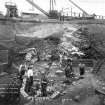South Sutor, Coast Battery, Gun Emplacement, No. 1 Gun
Coastal Battery (First World War), Gun Emplacement (First World War)
Site Name South Sutor, Coast Battery, Gun Emplacement, No. 1 Gun
Classification Coastal Battery (First World War), Gun Emplacement (First World War)
Alternative Name(s) Cromarty Defences; Fort South Sutor; Site No. 4
Canmore ID 170769
Site Number NH86NW 11.03
NGR NH 81055 66958
Datum OSGB36 - NGR
Permalink http://canmore.org.uk/site/170769
- Council Highland
- Parish Cromarty
- Former Region Highland
- Former District Ross And Cromarty
- Former County Ross And Cromarty
Coastal batteries on the headlands of North and South Sutor protected the port of Invergordon and the Cromarty Firth during the First and Second World Wars. Photographs show that construction of at least one gun emplacement, and associated buildings, began before the start of the First World War.
Information from RCAHMS (SC) 30 July 2007
NH86NW 11.03 81055 66958
A single World War I gun-emplacement for a 9.2-inch gun. Information to follow.
This World War I gun battery is situated within the area covered by the later World War II installations. Most of the buildings which comprise this earlier battery are extant within private land behind a metal fence.
Forming part of what is probably the most complete coast battery in Scotland. The World War I battery was armed with a single 9.2-inch gun which was manned by the Royal Navy.
J Guy 2000; NMRS MS 810/10, Vol.2, 88
Note (23 July 2013)
An emplacement for a 9.2-inch gun built by the admiralty to a designed influenced by the mounting and operation of a heavy gun on a Royal Navy ship.
The gun was mounted on an egg-shape barbette sunk into the concrete. Around the gun towards the Moray Firth side was an apron of concrete and a guard rail to stop the gun traversing too far to the west. The shells and cordite were hoisted up from the magazine below, as it would be on a ship. There are no ready ammunition lockers around the emplacement, so when operational the shells and cordite were passed up directly into the gun as required
The magazine lay below the gun emplacement, comprising two rooms and passageways with access via stairs to the rear. Originally some light was provided by windows to the shell store but these were later blocked up. Two doors entered the magazine, one into the shell store and one, via a lobby, into the magazine (cordite). The magazine did not have natural light and only light was provided by a electric safety lighting, enclosed behind glass in a recess in the wall beside a second doorway to a passageway between the shell store and the magazine, from which a further short passageway extended to the shaft containing the hoist to the gun.
On the south side of the gun emplacement was a crew shelter, a single room which once held a stove. Evidence of possible First World War camouflage is visible on the north wall of the crew shelter.
Information from RCAHMS (AKK) 23 July 2013.
Project (March 2013 - September 2013)
A project to characterise the quantity and quality of the Scottish resource of known surviving remains of the First World War. Carried out in partnership between Historic Scotland and RCAHMS.




























